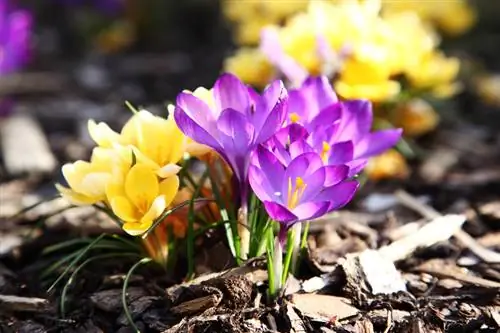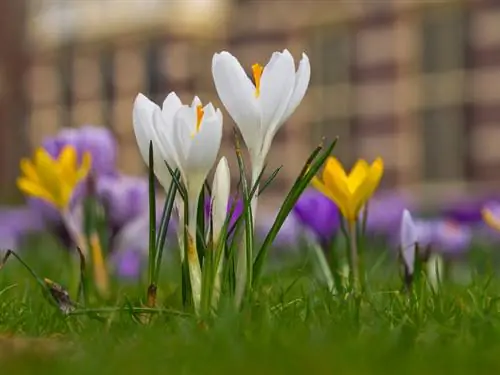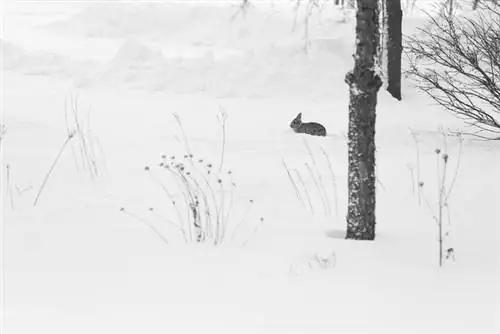- Author admin [email protected].
- Public 2023-12-16 16:46.
- Last modified 2025-06-01 06:02.
There is hardly a garden in which a few crocuses do not provide the first points of color in spring. Not all varieties bloom in spring; the autumn crocus only blooms in autumn. The robust ornamental plant is easy to plant and requires little care.

What is a crocus in the garden?
Crocuses are hardy ornamental plants in the iris family with over 80 species and bring color to the garden in spring and autumn. They require little care, grow 10-15 cm tall and bloom in white, yellow, violet or purple. Voles can damage crocuses.
The crocus: a profile
- Botanical name: Crocus
- Plant family: Iris family
- Order: Asparagus-like
- Origin: probably Greece
- Distribution: represented worldwide
- Species: around 80, 10 of which are in Germany plus breeding
- Height: 10 - 15 centimeters
- Flowers: flower tube with 3 stamens
- Flower colors: white, yellow, violet, purple predominant
- Leaves: green, narrow, lancet-like
- Flowering period: February to May / September to October
- Fragrance: Large-flowered varieties, slightly scented
- Lifespan: 2 - 6 years
- Propagation: seeds, bulbs
- Winter hardiness: completely hardy
- Toxicity: weakly toxic to humans, highly toxic to animals
- Special features: ovary forms underground
- Use: ornamental plant in the garden, first spring bloomers
Over 80 species of crocus are known
Crocuses are grown wherever the climate is temperate. Over 80 different species are known. Ten species are represented in Europe.
Wild crocuses grow in meadows and ditches and are often found in the Alps and foothills of the Alps. They are increasingly being planted in home gardens. Its flowers are predominantly light purple.
Over time, countless varieties have come onto the market. They differ in flower color, flower size and flowering time.
Crocuses hardly require any care
Once planted, the crocus grows in the garden for between two and six years. It forms numerous breeding tubers that provide new flowers next spring.
Crocuses are completely hardy and don't mind another cold outbreak. The cells of the flowers are protected against frost, so the crocus can even grow through blankets of snow.
The crocus thrives best if you simply leave it alone. The only major problem is voles, which can drastically reduce the crocus population. Occasionally the pests move the bulbs to another location, causing new crocuses to grow in completely unexpected places.
Tips & Tricks
The stamens of saffron, Crocus sativus, have been a popular seasoning and coloring agent since ancient times. The threads must be picked out by hand. Real saffron is therefore one of the most expensive spices ever.






